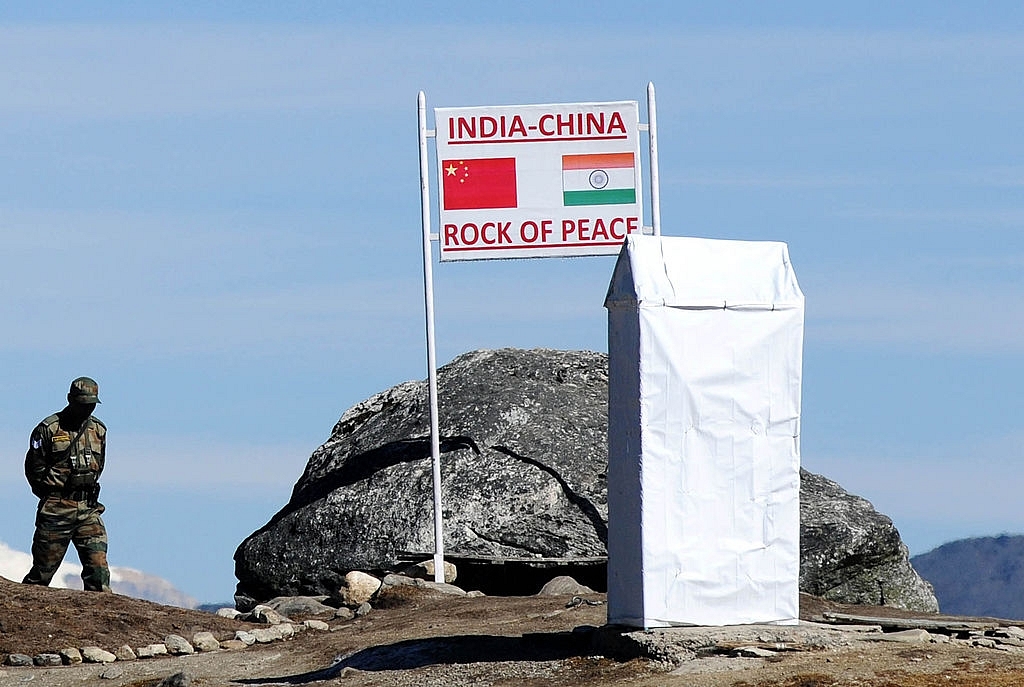Defence
Doklam Row: India’s Measured Poise Wins Against Wanton Chinese Aggression
- India’s diplomatic machinery has proven beyond doubt its competency and noble intentions vis-à-vis its neighbourhood and created requisite pressure on the Chinese side to retreat to status quo and let peace prevail on the border.
- And yes, the India of 2017 is not the India of 1962.

An Indian Army soldier keeps a vigil at Bumla pass at the India-China border. (BIJU BORO/AFP/Getty Images)
The Doklam stand-off that had been triggered by China’s unilateral action to change status quo in Bhutanese territory and India’s subsequent involvement to guard its friend’s interests as well as its own, finally saw a significant thaw in relations between India and China. The Indian side, witnessing road construction activities by China, had halted the latter’s troops at the sensitive and strategically significant tri-junctional border area, putting Chinese authorities in a fit of rage.
It was followed by Chinese putting their full state media machinery and psychological warfare to intimidate India into withdrawing. Not to be threatened by empty war rhetoric, India called out China’s bluff by remaining steadfast in its resolve to return to status quo at Doklam Plateau without indulging in a slugfest despite obvious and overt provocations.
The firmness displayed on the Indian side in the face of a seething Dragon was the result of past three years’ diplomatic groundwork laid down by Prime Minister Narendra Modi which was a calibrated blend of economic, strategic and humanitarian cooperation with the near and the extended neighbourhood.
Contrast this to the situation in 1962, when China was able to torpedo an unprepared India. Chinese aggression, despite the background of Jawaharlal Nehru’s unequivocal support for China’s United Nations Security Council membership and other sops, opened up deep fissures in the military preparedness of India. It had exposed the level of laxity, unmerited interference and wilful neglect of India’s defence forces. India’s isolation in the wake of major attack on its sovereignty was overlooked by the superpowers and even her so-called friends remained distant in the hour of need.
In 2017, the situation has reversed with China’s tantrums and expansionary motives finding no takers. In fact, at a time, when China was running bellicose editorial pieces and making racist videos to garner support for its actions, India had nations like Japan backing its stand to maintain the status quo and resolve the dispute peacefully.
Japan came out in full support of India’s stand on the issue with Japanese Ambassador to India, Kenji Hiramatsu stating:
Experts in US praised India’s policy of restraint pointing to its growing stature in Asia. James R Holmes, Professor of Strategy at the US Naval War College, said,
With both the parties agreeing to disengage their troops from the Doklam Plateau, India has scored a diplomatic victory against the a clearly bigger economic power without firing a single gunshot. Prime Minister Narendra Modi’s hard diplomacy behind calm posturing has thwarted the attempts of China towards occupation of Bhutanese territory.
Another big win registered by the Indian side is that it has proven its legitimacy in the region as a pivot against Chinese expansionism. In standing up for a friendly nation like Bhutan, which does not have any match for a power like China, India’s commitment to other smaller nations in the region has been reiterated. This is a stark contrast from the Indian establishment of 1950s and 60s which not only gave up on a friend like Tibet but also had Nehru kissing goodbye to the Northeast through an infamous radio address.
One of the leading online foreign policy sites underscores India’s intervention in the Doklam region stating:
Another American Foreign Policy Expert Jeff M Smith admired the manner in which Modi administration secured Indian and Bhutanese interests without escalation, on social media site, Twitter:
Head of National Security College, Australian National University, Rory Medcalf appreciated India’s confident demeanour against Chinese aggression, saying:
Indian analyst Brahma Chellaney explained the scale of Indian victory in his following tweet:
Indian analyst Samir Saran too lauded the Indian establishment for standing up to a bully, and securing its friend’s interests along with its own.
Even publications like Washington Post said:
India’s diplomatic machinery has proven beyond doubt its competency and noble intentions vis-à-vis its neighbourhood and created requisite pressure on the Chinese side to retreat to status quo and let peace prevail on the border. And yes, the India of 2017 is not the India of 1962.
Support Swarajya's 50 Ground Reports Project & Sponsor A Story
Every general election Swarajya does a 50 ground reports project.
Aimed only at serious readers and those who appreciate the nuances of political undercurrents, the project provides a sense of India's electoral landscape. As you know, these reports are produced after considerable investment of travel, time and effort on the ground.
This time too we've kicked off the project in style and have covered over 30 constituencies already. If you're someone who appreciates such work and have enjoyed our coverage please consider sponsoring a ground report for just Rs 2999 to Rs 19,999 - it goes a long way in helping us produce more quality reportage.
You can also back this project by becoming a subscriber for as little as Rs 999 - so do click on this links and choose a plan that suits you and back us.
Click below to contribute.
Latest